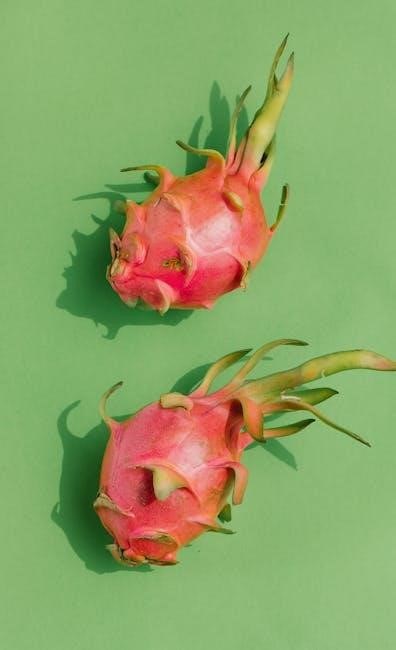
dragon fruit diseases and treatments pdf
Dragon Fruit Diseases and Treatments
Dragon fruit crops face threats from fungal and bacterial diseases‚ impacting yield and quality․ Effective management integrates preventative measures‚ chemical controls‚ and cultural practices․ Post-harvest treatments like hot water immersion help reduce disease incidence and maintain fruit quality․
Common Fungal Diseases
Dragon fruit plants are susceptible to various fungal diseases that can significantly impact their health and productivity․ These diseases often manifest as stem cankers‚ fruit rots‚ or blight‚ affecting different parts of the plant․ Bipolaris cactivora causes fruit rot‚ while other fungi contribute to stem canker and rot․ Gray blight‚ identified in Malaysia‚ is another fungal disease affecting dragon fruit stems․ Anthracnose‚ caused by Colletotrichum species‚ is also a common fungal infection․ Understanding these fungal diseases is crucial for implementing effective management strategies․ Proper identification and timely intervention are essential to minimize losses and maintain healthy dragon fruit production․
Stem Canker and Rot
Stem canker and rot are significant threats to dragon fruit cultivation‚ leading to substantial losses if left unmanaged; These diseases are primarily caused by fungal pathogens that attack the plant’s stems‚ leading to lesions and decay․ Phomopsis species are known to contribute to stem and collar rots․ Environmental factors like high humidity and poor ventilation exacerbate the development of these diseases․ Symptoms include sunken‚ discolored areas on the stems‚ which can eventually lead to complete rot․ Preventative measures‚ such as proper pruning and maintaining good hygiene in the orchard‚ are crucial for managing stem canker and rot․ Early detection and prompt treatment are essential for mitigating the impact of these diseases․
Fruit Rot (Bipolaris)
Bipolaris cactivora is a fungal pathogen known to cause fruit rot in dragon fruit‚ leading to significant post-harvest losses․ The fungus infects the base of immature fruits‚ causing yellowing and soft rot․ Warm‚ humid conditions favor the development and spread of this disease․ Lesions caused by Bipolaris result in large areas of soft rot‚ rendering the fruit unmarketable․ Management strategies include temperature control‚ hot water treatments‚ and gamma irradiation to reduce disease incidence and severity․ Maintaining orchard hygiene‚ proper ventilation‚ and avoiding fruit injuries during harvest can also help minimize the risk of Bipolaris fruit rot․ Early detection and prompt action are crucial for controlling this disease․
Gray Blight

Gray blight is a fungal disease affecting dragon fruit stems‚ identified by morphological‚ molecular‚ and pathogenicity analyses․ It has been observed in Malaysia on red-fleshed dragon fruit (Hylocereus polyrhizus)․ The disease is characterized by blighted stems‚ from which fungal isolates can be obtained; Proper orchard management practices are essential to prevent the spread․ The specific pathogen responsible for gray blight requires accurate identification for effective control strategies․ Research is ongoing to determine the most effective fungicides and cultural practices to manage gray blight in dragon fruit farms․ Further studies are needed to understand the epidemiology and lifecycle of the causal fungus․ Early detection and removal of infected stems are critical to minimize losses․ Preventative treatments and maintaining optimal growing conditions can help reduce the incidence of gray blight․
Anthracnose
Anthracnose is a fungal disease that can affect dragon fruit‚ leading to significant crop losses․ The disease is caused by various Colletotrichum species․ It manifests as dark‚ sunken lesions on stems and fruits․ Warm and humid conditions favor the development and spread of anthracnose․ Disease management involves preventative measures‚ including proper sanitation and pruning․ Chemical control using fungicides can also be effective in reducing disease severity․ Regular monitoring for symptoms is crucial for early detection and intervention․ Cultural practices such as ensuring good air circulation and avoiding overhead irrigation can help minimize the risk of infection․ Integrated disease management strategies are essential for long-term control․ Post-harvest treatments may also help in reducing the incidence of anthracnose․ Proper identification of the specific Colletotrichum species is important for targeted control measures․

Bacterial Diseases
Dragon fruit plants are susceptible to bacterial diseases‚ such as those caused by Xanthomonas campestris‚ leading to stem and collar rots․ These infections can severely damage crops‚ necessitating proactive management strategies and preventive measures for effective control․
Xanthomonas Campestris
Xanthomonas campestris is a bacterial pathogen known to cause significant problems in dragon fruit farms‚ particularly stem and collar rots․ This bacterium thrives in warm‚ humid conditions‚ making dragon fruit crops in tropical climates especially vulnerable․ The infection often leads to lesions and decay at the base of the stem‚ potentially causing plant death if left unmanaged․ Effective control strategies include preventive treatments‚ such as ensuring proper orchard hygiene and applying bactericides․ Regular pruning and removal of infected plant parts are crucial in preventing the spread of Xanthomonas campestris․ Additionally‚ cultural practices that promote air circulation and reduce humidity can help mitigate the risk of infection‚ safeguarding the health and productivity of dragon fruit plants․

Insect Infestations
Dragon fruit plants are susceptible to various insect infestations‚ including scale insects‚ ants‚ beetles‚ snails‚ and birds․ These pests can cause significant damage to stems‚ fruits‚ and overall plant health‚ impacting yield and quality․
Scale Insects
Scale insects‚ belonging to the superfamily Coccoidea‚ pose a significant threat to dragon fruit plants․ These sap-sucking insects‚ comprising over 8‚000 species‚ can weaken plants and reduce fruit production․ Infestations often appear as disease symptoms‚ with scales attaching themselves to stems and fruits․ Ants are known to farm scale insects‚ exacerbating the problem․ Effective treatment involves physical removal‚ such as rubbing with isopropyl alcohol‚ and addressing ant infestations․ Regular monitoring and timely intervention are essential to control scale populations and minimize damage to dragon fruit crops‚ ensuring healthy plant growth and optimal fruit yield․
Ants
Ants‚ while not directly harmful to dragon fruit plants‚ play a significant role in pest management by fostering relationships with sap-sucking insects like scale insects․ These insects excrete honeydew‚ a sugary substance that ants feed on․ In return‚ ants protect these pests from predators and help them spread to new areas of the plant․ Controlling ant populations is crucial in managing scale infestations and preventing secondary fungal infections․ Employing ant baits and barriers can disrupt their activity and reduce their ability to protect harmful pests․ Integrated pest management strategies should prioritize ant control to promote overall plant health․
Other Pests (Beetles‚ Snails‚ Birds)
Dragon fruit plants encounter a range of other pests‚ including beetles‚ snails‚ and birds‚ each posing unique challenges․ Beetles can damage stems and fruits through feeding‚ while snails consume plant tissues‚ creating entry points for pathogens․ Birds may peck at ripening fruits‚ causing economic losses․ Management strategies vary depending on the specific pest․ For beetles and snails‚ manual removal‚ traps‚ and appropriate insecticides can be effective․ Protecting fruits from bird damage can involve netting or other physical barriers․ Regular monitoring for pest activity and prompt intervention are essential to minimize damage and maintain healthy dragon fruit production․

Disease Management Strategies
Effective disease management in dragon fruit involves a multi-faceted approach․ Preventative treatments‚ judicious use of chemical controls‚ cultural practices like pruning‚ and post-harvest treatments are all vital for minimizing disease impact and ensuring fruit quality․
Preventative Treatments
Implementing proactive measures is crucial in dragon fruit cultivation to minimize disease incidence․ These treatments focus on creating an environment less conducive to pathogen development․ Maintaining orchard hygiene by removing diseased plant material promptly reduces inoculum sources․ Ensuring proper spacing and air circulation through pruning helps to lower humidity levels‚ discouraging fungal growth․
Furthermore‚ promoting plant health through balanced fertilization and adequate watering strengthens their natural defenses against infection․ Some growers use preventive applications of bio-control agents or copper-based fungicides‚ especially during periods of high disease risk․ Shade management through cladode hardening in shade is also beneficial․
Regular monitoring for early signs of disease enables timely intervention‚ preventing widespread outbreaks․ Remember the sodium salt solution at 30 g/L applied twice a week‚ along with rotating chemical fungicides applied once a week‚ were able․
Chemical Control (Fungicides)
When preventative measures are insufficient‚ fungicides become necessary to manage dragon fruit diseases․ Selecting appropriate fungicides depends on the specific pathogen and local regulations․ Copper-based fungicides are commonly used for broad-spectrum protection against fungal and bacterial diseases․ Systemic fungicides offer more targeted control and can be absorbed by the plant‚ providing longer-lasting protection․
Always follow label instructions carefully regarding application rates‚ timing‚ and safety precautions․ Rotating different classes of fungicides helps prevent the development of fungicide resistance in pathogen populations; Consider environmental impact and choose products with minimal harm to beneficial organisms․ Integrating chemical control with other management strategies enhances overall effectiveness․
Remember that the sodium salt solution at 30 g/L applied twice a week‚ along with rotating chemical fungicides applied once a week‚ were able to reduce the disease severity of the stem canker disease on the dragon fruit․
Cultural Practices (Pruning‚ Hygiene)
Cultural practices are crucial for maintaining healthy dragon fruit plants and minimizing disease outbreaks․ Regular pruning improves air circulation within the canopy‚ reducing humidity and creating an environment less favorable for fungal growth․ Remove and destroy any diseased stems‚ fruits‚ or flowers promptly to prevent the spread of pathogens․ Proper hygiene includes sanitizing pruning tools with a disinfectant solution between cuts to avoid transmitting diseases․
Maintain a weed-free environment around the plants to reduce competition for resources and eliminate potential hosts for pests and diseases․ Ensure adequate spacing between plants to promote airflow and sunlight penetration․ Implementing these cultural practices alongside other management strategies significantly contributes to disease prevention and overall plant health․
Pruning practices‚ cladode hardening in shade and treatment of carbendazim (0․1) or copper oxychloride are other important cultural practices which help control disease․
Post-Harvest Treatments (Hot Water)
Post-harvest treatments are essential for minimizing disease development during storage and transportation of dragon fruit․ Hot water treatment is a common method used to reduce fungal infections and extend shelf life․ Immersing the harvested fruits in hot water for a specific duration can effectively kill or inhibit the growth of pathogens present on the fruit surface․
Temperature management‚ hot water treatment‚ and gamma irradiation have been reported to reduce disease incidence and severity of dragon fruits․ It is crucial to carefully control the water temperature and immersion time to avoid damaging the fruit․ This method helps maintain the quality and marketability of dragon fruit by preventing post-harvest decay caused by fungal pathogens․ Hot water treatments also contribute to overall consumer satisfaction․